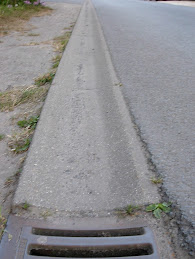Yesterday I raced a UCI in Reningelst, which is a small town near Ieper. The race was very similar to a kermis in that it was held on a circuit and had many turns and narrow roads. We were to do one lap of 10km and then ten laps of 16km. Many notable teams were present including Beveren 2000 (Quickstep's amateur team), Cerdi, and VC Roubaix. The USA U23 National Team also had guys there. After about 45 minutes a break had formed and the peleton would spend the next 3 hours slowly closing the gap, with many attacks in between in attempt to bridge. The leaders never had more than 2 minutes on the peleton, which proves that the pace was very fast.
I had some trouble staying near the front in the early part of the race. It took me a few laps to learn the roads and wind and to figure out he best places to make a move to the front. I once hopped on the sidewalk when the pace let up and sprinted all the way to the front just before coming back on the road to make the turn onto the narrowest road of the race. I was the first through the turn! It is much easier and safer to be in the front, especially in a race like this. The accelerations out of the corners are much slighter when you are in the first 20 through the corner. It sound so easy: stay at the front, but within a lap of me being in first position I was back in mid-pack, which in this case was around 80th. Getting to the front is one thing ...staying at the front is a whole different ballgame. There are times in the race when all you can do is hold on to the wheel in front of you and pray that no one opens a gap. Actually there were many of these times in yesterday's race. One section in particular seemed to open up gaps on every lap (another reason to be at the front). After about 3 hours of racing, a gap opened up a few places ahead of me and no one could close it down. Everyone was single file and suffering very badly. Many guys called it a day and quit the race when they couldn't get back to the peleton. I was in a group of 12 guys that were not yet ready to give up. We worked very hard for almost a full lap and eventually got back to the peleton. I knew at that moment I needed to get to the front because in the next hard section the race would be ripped to shreds. I moved up to the middle and could feel that the end was near for me. I had pushed my body very hard and dug very deep to get back to the peleton. On the next hill I slowly drifted to the back as my heart rate went through the roof. This was the end. I gave it one last shot on the downhill but the gap continued to open. 3.5 hours and I was done. Very close considering the winning time was 4 hours and 3 minutes.
There is a huge mental aspect of racing in Belgium that I am starting to learn and adopt. The best advice that I have ever received about racing in Belgium is that 'You can always ride harder!' This statement is very true. There are moments when the race is single file and there are 150 guys riding in the gutter and you're mind is telling your body to stop. I am learning that you can tell your body to go that little bit further. You can block that signal that is telling your body to stop. You can embrace the pain. You can always go that little bit further. And I'm getting better at doing that. I can remember 3 specific times yesterday when I shut my mind off and just went that little bit harder and it kept me in the race much longer. I know that I am strong enough to finish these races and my cleverness during races is improving too. I am continuing to learn in every race I do. My next shot is a UCI in France tomorrow. Wish me luck. VR


